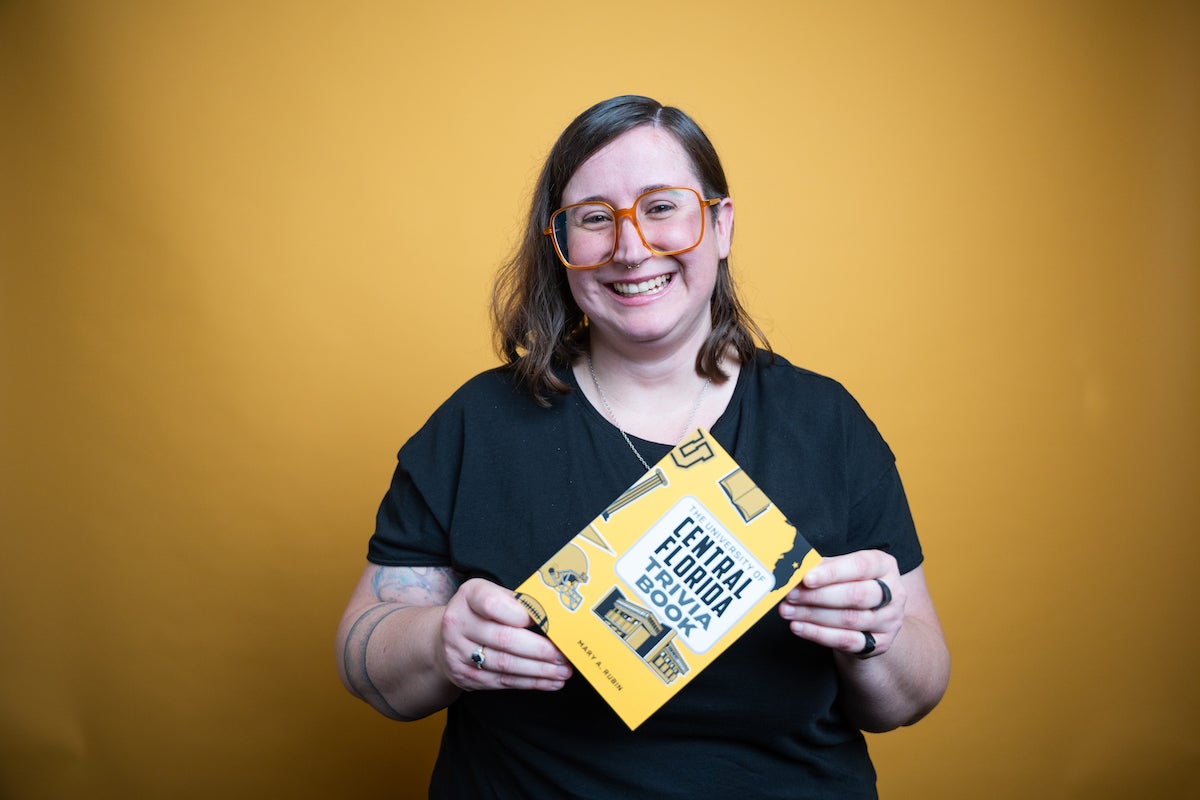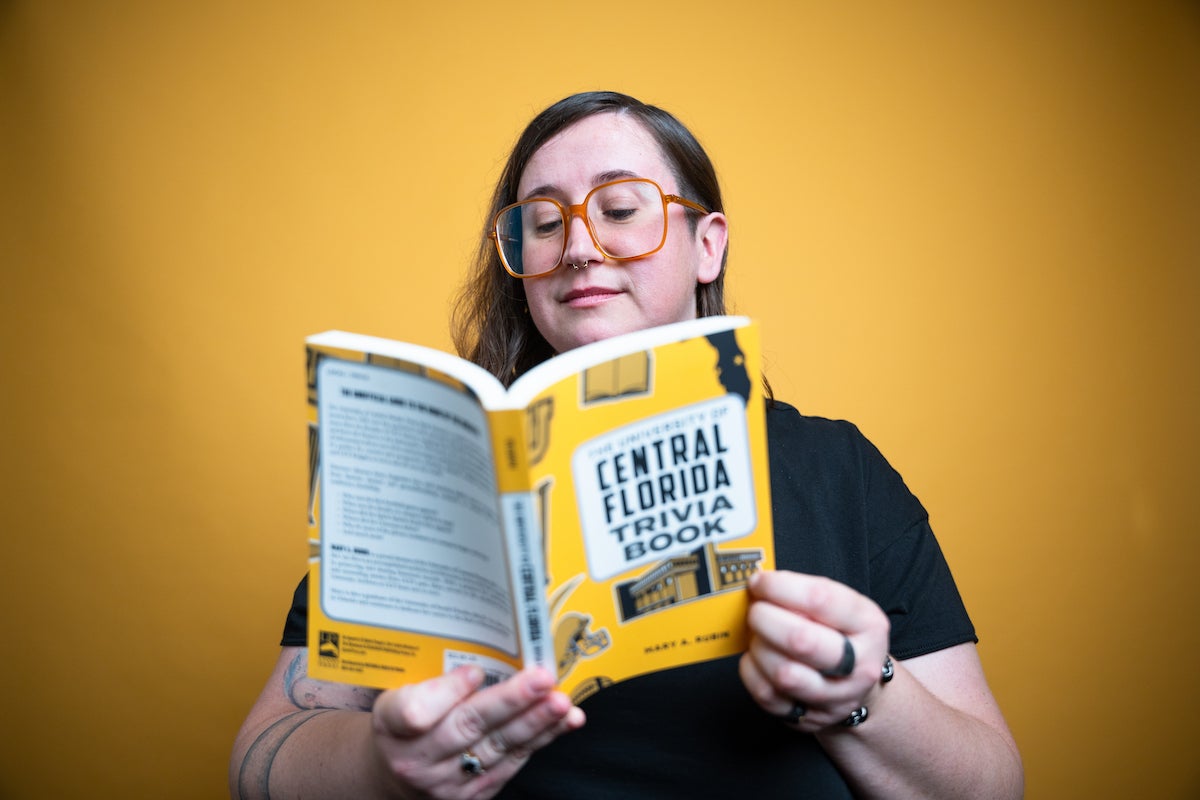Did you know UCF was informally called the “space university” before it had an official name? Or that Knightro became UCF’s official mascot in Fall 1995, even though he first appeared a year earlier?
These snippets of knowledge offer a glimpse into the history of Knight Nation, and thanks to alum and former UCF archivist Mary Rubin ’12 ’19MA, can be found within the pages of The University of Central Florida Trivia Book.
Rubin shares a mix of interesting tidbits, profound insights and undisputed truths, along with quotes from some of the best known and relatively unknown people who’ve been associated with UCF. Her book isn’t meant to encompass the entirety of knowledge about UCF; rather, its purpose is to provide readers with a peek into the institution’s history, whether they’re prospective students, current students or devoted alumni, she says.
Since its establishment in 1963, UCF has forged a remarkable path through six decades of history. As this year marks UCF’s 61st birthday, Rubin’s book highlights how the institution has remained a vibrant epicenter of life through the years.
Here, Rubin shares her journey of accumulating a wealth of knowledge about UCF as both an interdisciplinary studies undergraduate and digital media graduate student, as well as a former archivist for the University Archives at UCF. She also reveals the inspiration for her trivia book and emphasizes the importance of maintaining a university archive.

Can you share any early experiences or influences that sparked your passion for preserving historical records?
I just fell into it. I did my undergraduate studies at UCF in completely unrelated fields. An IT job I had at the UCF Library in 2012 was my first introduction to archiving. Since I was tasked with coding work in the archives, I didn’t really get into archiving for the history initially. But once all the coding work was done, I started working on history and learned so much more about UCF.
I started my IT job around the time UCF celebrated its 50th birthday, so I was doing a lot of research in the archive about the university’s history. Some of the interesting discoveries I made were the origins of on-campus building names and the Reflecting Pond. Documents go back and forth referring to the iconic campus landmark as either “Reflection Pond” or “Reflecting Pond.” Being able to verify the official name “Reflecting Pond” was interesting — I loved doing that work.
What were some of the most surprising or intriguing discoveries you made as a former archivist for the University Archives at UCF for a decade?
I got a very privileged perspective of UCF working with the history as an employee. One of the hardest moments to capture for me was after the tragic attack at Pulse nightclub. There were boards in the Student Union that had notes from students. Some of my colleagues and I retrieved the notes to create a Pulse collection. To be able to capture that moment in time was special and especially sobering.
Another project I worked on for years at UCF was the origin of Spirit Splash. There have been many stories and people claiming that they know the actual origin. While I was working on homecoming history, I was able to do an oral history interview with UCF alumnus Trey Gordon ’96, who confirmed details about the history of UCF’s mascot, Knightro, and the history of Spirit Splash. Eventually, I helped find some photos in a student newspaper that captured people in the Reflecting Pond in 1994. Although the people were hard to make out in the newspaper since it’s in black and white, Gordon was able to produce the actual color photos that were used in the newspaper. You could see that people were in the water. The story had always been that the 1995 student government president was pushed into the water and then everybody jumped in. Now there’s actual proof that there were people in the water in 1994. I enjoyed hearing stories like this, finding little pieces of evidence and making all the connections.
As UCF celebrates its 61st birthday June 10, what significance does maintaining a university archive hold, and how does it contribute to the institution’s identity and legacy?
UCF is in a great position to preserve its history. As a young institution, UCF is in a great place to be able to capture its history, to celebrate its traditions and to make new ones. I’m very happy that I got to be at UCF for a decade to spread the word, to preserve those records and to capture them.
What inspired you to write a trivia book about UCF, and how did you determine its content?
I was contacted by the publisher right as I was leaving my job at UCF, so I thought that writing this book was a good way to brain dump everything that I knew about the university. The book was a good closure to my time at UCF.
I had to create a minimum of 650 questions and quotations. The first 100 questions were very easy. I just typed them out to get them out of my brain. Questions 400 to 650 took more work.
Can you describe how you researched and gathered the historical facts for the book?
The research process was methodical. I searched through nearly every volume of the former UCF student newspaper, Central Florida Future, looking at headlines and saying to myself, “Does this sound good to me? Do I think a student or an alumni would be interested in this kind of thing?” Then I went through all the digital resources that were available, including the UCF Today website.
The book draws heavily from the UCF Special Collections & University Archives department’s extensive collection of campus newspapers, magazines, yearbooks, archival collections and other published materials spanning six decades. Additionally, both past and present members of the UCF community shared their stories or contributed to satirical blogs, the UCF subreddit and several other publications and online forums.
Were there any anecdotes or surprising little-known facts about UCF that you discovered during your research?
One of the interesting things I didn’t know was about UCF’s art collection. As I was being methodical with my research, I was thinking of all the subject areas that I wanted to cover and all the different aspects of UCF. At some point I wrote down that I wanted to learn more about the art at UCF, which I had no knowledge about throughout my time as an archivist at the university.
How was the public art collection at UCF acquired?
Through multiple means. The Art-In-State Buildings Program acquires artwork for new public facilities built by state funds. The Kotteman Collection, which consists of contemporary outdoor sculptures, was entrusted to the university by George and Norma Kottemann. The university has also commissioned pieces and received art through donations.
— Page 178 of The University of Central Florida Trivia Book
The creation of the Student Union is also an interesting one for me. In the book, I include several questions about the master plans for UCF and how the university’s first president, Charles Millican, and subsequently its second president, Trevor Colbourn, both wanted to leave the space in the middle of UCF’s main campus as a nature preserve. UCF’s third president, Steven Altman, felt that the university’s deficiency was that it didn’t have a big Student Union, which should be in the center of campus. I think this was the right decision. I recall the Student Union being a well-established part of student life during my time as a UCF student in the late 2000s.
Now that you’ve authored a trivia book, are there any other writing projects or areas of research you’re excited to explore?
The UCF trivia book was just a fun, one-off project for me. I haven’t figured out what my next subject matter expertise will be, but I do consider myself a subject matter expert on UCF.




